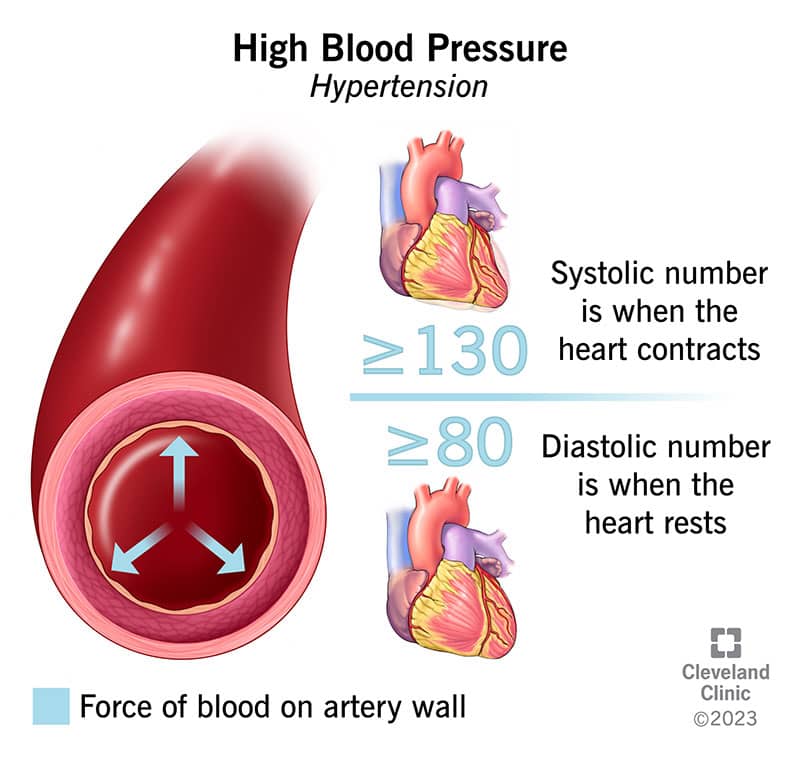
High Blood Pressure: What You Need To Know – Cleveland Clinic
High blood pressure (hypertension) has no symptoms and can be dangerous if not treated. Hypertension puts you at risk for stroke, heart attack and other problems. Nearly half of adults who have hypertension don’t realize it. So, checkups are crucial. Dietary changes, exercise and medicine can help you keep your blood pressure where it should be.
High blood pressure is when the force of blood pushing against your artery walls is consistently too high. This damages your arteries over time and can lead to serious complications like heart attack and stroke. “Hypertension” is another word for this common condition.
Healthcare providers call high blood pressure a “silent killer” because you usually don’t have any symptoms. So, you may not be aware that anything is wrong, but the damage is still occurring within your body.
Blood pressure (BP) is the measurement of the pressure or force of blood pushing against blood vessel walls. Your BP reading has two numbers:
Healthcare providers measure blood pressure in millimeters of mercury (mmHg).
Getting your blood pressure checked is the only way to know if it’s too high. You can do this by seeing a healthcare provider for a yearly checkup, even if you feel healthy. You won’t feel sick if you have high blood pressure. So, these checkups are crucial and can be life-saving. If your BP is above the normal range, your provider will recommend lifestyle changes and/or medications to lower your numbers.
Definitions of high blood pressure vary slightly depending on where you live. In the U.S., healthcare providers define high blood pressure (hypertension) as:
In Europe, healthcare providers define hypertension as:
High blood pressure is very common. It affects 47% of adults in the U.S. This equals about 116 million people. Of those, 37 million have a blood pressure of at least 140/90 mmHg.
High blood pressure caused or contributed to over 670,000 deaths in the U.S. in 2020.
The World Health Organization estimates that globally, over 1.2 billion people ages 30 to 79 have hypertension. About 2 in 3 of those individuals live in low- or middle-income countries.
Advertisement
Cleveland Clinic is a non-profit academic medical center. Advertising on our site helps support our mission. We do not endorse non-Cleveland Clinic products or services. Policy
Usually, high blood pressure causes no signs or symptoms. That’s why healthcare providers call it a “silent killer.” You could have high blood pressure for years and not know it. In fact, the World Health Organization estimates that 46% of adults with hypertension don’t know they have it.
When your blood pressure is 180/120 mmHg or higher, you may experience symptoms like headaches, heart palpitations or nosebleeds. Blood pressure this high is a hypertensive crisis that requires immediate medical care.
Your provider will diagnose you with one of two types of high blood pressure:
Primary and secondary high blood pressure (hypertension) can co-exist. For example, a new secondary cause can make blood pressure that’s already high get even higher.
You might also hear about high blood pressure that comes or goes in certain situations. These hypertension types are:
Advertisement
Primary hypertension doesn’t have a single, clear cause. Usually, many factors come together to cause it. Common causes include:
Secondary hypertension has at least one distinct cause that healthcare providers can identify. Common causes of secondary hypertension include:
Researchers believe genes play a role in high blood pressure. If one or more of your close biological family members have high blood pressure, you have an increased risk of developing it, too.
Risk factors that make you more likely to have high blood pressure include:
Untreated hypertension may lead to serious health problems including:
Advertisement
Healthcare providers diagnose high blood pressure by measuring it with an arm cuff. Providers usually measure your blood pressure at annual checkups and other appointments.
If you have high blood pressure readings at two or more appointments, your provider may tell you that you have high blood pressure. They’ll talk to you about your medical history and lifestyle to identify possible causes.
In 2017, the American College of Cardiology and American Heart Association issued new blood pressure guidelines. Healthcare providers in the U.S. use these when diagnosing and treating high blood pressure. The guidelines divide blood pressure readings into four categories, listed in the chart below. You have high blood pressure if you fall into the stage 1 hypertension or stage 2 hypertension categories.
In the U.S., a high blood pressure diagnosis means your top number is at least 130 and/or your bottom number is at least 80.
High blood pressure treatments include lifestyle changes and medications. Healthcare providers recommend treatment based on your blood pressure readings, the causes of your high blood pressure and your underlying conditions.
You may be wondering if you can lower your blood pressure naturally. Yes, in some cases, it’s possible to lower your blood pressure without medication. For example, your provider may recommend starting with lifestyle changes if you have elevated blood pressure or stage 1 hypertension.
Here are some proven ways to lower your blood pressure naturally:
Sometimes, providers recommend lifestyle changes along with medications to lower your blood pressure.
Four classes of blood pressure medications are “first-line” (most effective and commonly prescribed) when starting treatment:
Your provider may couple other medications with these first-line drugs to better manage your blood pressure.
Talk to your provider about possible side effects. If you get side effects that concern you, call your provider. They may change your dose or try a different medication. Don’t stop taking the medicine on your own.
You should avoid some medications during pregnancy. So, be sure to tell your provider if you’re pregnant or could become pregnant.
Fortunately, there are things you can do to reduce your risk of developing high blood pressure. These include:
Since high blood pressure doesn’t cause symptoms, you probably won’t feel any different with a high blood pressure diagnosis. But it’s important to follow your provider’s instructions to bring your blood pressure down so it doesn’t cause complications later on.
Once high blood pressure leads to complications, you may start to feel symptoms of conditions like coronary artery disease or peripheral artery disease. These include:
Your provider may recommend you check your blood pressure regularly with a home blood pressure monitor. These are automated electronic monitors you can purchase at most pharmacies or online. For some people, 24-hour ambulatory blood pressure monitoring is necessary.
If you have primary high blood pressure, you’ll need to manage it for the rest of your life.
If you have secondary high blood pressure, your blood pressure will most likely come down after you receive treatment for the medical problem that caused it. If a medication caused your high blood pressure, switching to a different medicine may lower your blood pressure.
See your provider for yearly checkups. They’ll monitor your blood pressure and recommend treatment, if needed, to help you stay healthy.
Call 911 or your local emergency number if you have sudden symptoms of a hypertensive crisis. These include:
Questions that can help you learn more about your risk for high blood pressure or ways to manage existing high blood pressure include:
Research supports the DASH diet as a way to lower blood pressure naturally. Increasing potassium and reducing sodium through your food choices are specific strategies.
You may read about many other dietary methods for lowering your blood pressure. These methods don’t have the same level or quality of evidence to support their effectiveness. They include:
Be a cautious consumer, and talk with your healthcare provider to learn more.
A note from Cleveland Clinic
High blood pressure is a serious but silent condition that can sneak up on you over the years. Seeing a healthcare provider for regular checkups can help you learn your numbers. If you don’t have access to care, learn about available community resources (such as wellness fairs) where blood pressure checks are available. Knowing your blood pressure levels is the first step toward making lifestyle changes that can help keep your arteries healthy.
Last reviewed on 05/01/2023.
Learn more about our editorial process.
Advertisement
Cleveland Clinic is a non-profit academic medical center. Advertising on our site helps support our mission. We do not endorse non-Cleveland Clinic products or services. Policy
